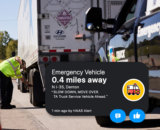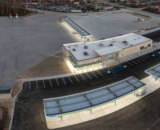Professional drivers and road warriors alike are looking for convenience when on the go. In return, truckstop and travel plaza operators are constantly finding new ways to make life easier for their customers, including techniques to expedite the fueling process so drivers can get back on the road faster. Operators nationwide are evaluating and installing new technology that ranges from cardless fueling to new pay-at-the-pump options in hopes that the added convenience will boost customer loyalty and win them repeat customers.
Cardless Fueling Technology
A number of locations, including Love’s Travel Stops, have already installed lanes with radio-frequency identification technology, also called RFID. The technology relies on a radio signal from a tag attached to the truck or trailer that sends a signal to a sensor located in the fuel island canopy. Once the sensor reads the tag and verifies the information with the carrier, the pump turns on and the driver can fuel the truck. The pump turns off when the truck pulls away.
Love’s Travel Stops has installed RFID at nearly all of its 240 travel stop locations and only “a handful of” locations don’t have the technology, said Jon Archard, director of fuel marketing for Love’s.
“For an industry where fuel transactions have remained largely unchanged since the 1970s, RFID technology has greatly enhanced the process,” said Jim Xenos, vice president of information technology and chief information officer for Love’s. “This technology is a game changer for the industry.”
While the technology is relatively new, use among carriers is growing steadily. Archard said, “More fleets are adopting the technology every week.”
For fleets, the technology can save drivers time, and it also provides added security. Pumps are automatically turned off by RFID software after a truck leaves the fueling bay, which can reduce fuel theft incidents.
“From the fleet perspective, it guarantees that the truck or trailer in the lane fueling is the fleet’s asset therefore reducing the potential for fraud. With a card-based payment, you know your driver is in that lane but not necessarily your truck or trailer,” said Trisha Torrado, a vice president at Comdata Corp.
There may also be safety benefits. “Because of the faster transaction processing, the driver is on the fuel island for a shorter amount of time lessening the possibilities of slipping or falling due to spilled fuel or oil,” Torrado said.
For carriers, not having to manage a magnetic-stripe card is a plus. “We’re back into the 100 percent driver turnover range. Just think about having to control that number of mag-stripe cards. Plus, with a mobile workforce, if a card gets damaged for any reason, you have to get one in a driver’s hands in a timely basis. That can be a challenge,” said Ernie Betancourt, president of QuikQ, which manufactures the hardware and software to process RFID transactions.
Love’s is using technology from QuikQ. QuikQ RFID transactions can be processed by its own DF Connect software, Comdata’s SmartQ or Retalix.
QuikQ licensed the technology to Comdata, which coordinates with a national company to complete the hardware installations. “They are able to work with each location and address their needs as well as overcome their unique obstacles with installations,” Torrado said.
The physics and geometry involved can make some installations complicated. “One of the challenges is the antenna needs to be a minimum of 15 feet and preferably 17 feet in front of the hose. It turns out that a lot of truckstop canopies aren’t that long,” Betancourt said.
To overcome the challenges, Love’s has extended canopies with a truss, Betancourt explained. “We’re working on coming up with some easier methods,” he said, adding that in most cases, installation takes about two days. RFID also allows carriers to track sales through a web-access portal, which Love’s expects to increase satisfaction among carriers and Love’s employees, Xenos explained.
New Pay-At-The-Pump Options
While pay at the pump is the norm for gasoline purchases, that isn’t the case for diesel sales. Schulte estimates that 90 percent or more of professional truck drivers have to go inside and get their receipt when they buy diesel.
Gilbarco Veeder-Root and PayPal have teamed up to bring PayPal to the pump at tens of thousands of fueling stations around the U.S. Gilbarco Veeder-Root said the move will allow retailers to connect more effectively with customers and simplify the way people pay for fuel and purchase in-store items. PayPal has 125 million global users and 55 million Americans who use the technology.
Through the partnership, Gilbarco Veeder-Root gains access to a new user base, while also giving merchants using Gilbarco’s equipment the ability to sell additional items through PayPal Wallet.
Parker Burke, payment product manager for Gilbarco Veeder-Root, said it is too early to tell if PayPal will be most attractive to fleet or passenger drivers. While Gilbarco Veeder-Root is currently developing the PayPal platform, Burke said it is too early to release a timeframe for its rollout.
The initial effort will launch the Pay- Pal payment capability to retailers with Passport point-of-sale. Future developments will expand Gilbarco’s use of Pay-Pal solutions to its other applications. Mike Schulte, president of Gilbarco North America, said, “The PayPal mobile solution will be a cornerstone of our suite of retail applications.”
Don Kingsborough, vice president of retail services for PayPal, said, “Pay-Pal wants to be where consumers shop every day and by collaborating with Gilbarco Veeder-Root, one of the leaders in the convenience store and fuel industry, it has the potential to put us into thousands of locations.”
Smartphone Payment Technology
Mobile payments using near-field communication devices allow shoppers to use their phone to complete their transactions. Retailers install near-field communication technology (NFC) that can read payment information from a shopper’s smartphone. The technology is expected to reach critical mass in 2013, and a report from ABI Research said more than 280 million NFC-enabled devices are expected to ship in 2013.
Google has launched Google Wallet— an app that allows shoppers to use their phone as their wallet. Google Wallet does not charge merchants fees for accepting payments via Google Wallet, and Google Wallet has partnered with First Data to set up in-store NFC readers.
“Mobile payments continue to be a topic that gets a lot of attention across the board,” Burke said. “The key to success is having benefits to both the retailers and the customer.”
Benefits to retailers can enhance loyalty and repeat visits, Burke explained. Experts anticipate fuel retailers will first use NFC devices inside the store before moving them to the fuel islands, but Gilbarco Veeder- Root is working towards pumps with NFC technology. “We have products that are in the final stages of development that support the mobile wallet, NFC devices,” Burke said.
To spur new payment solutions, including NFC devices, Visa has launched the Visa Ready Partner Program that it said would further drive the global migration from cash to electronic payments. The program is designed to provide innovators a path to ensure that devices, software and solutions used to initiate or accept Visa payments are compatible with Visa’s requirements, the company said. Visa said the program will make it easier for merchants to adopt new, innovative payment methods that are approved by Visa and can help them drive business growth by expanding the use and acceptance of electronic payments globally.
“The pace of innovation in the payments industry requires a new approach that ensures innovative payment methods can be tested, approved and commercialized quickly,” said Jim McCarthy, global head of product for Visa Inc. “While it is critical that we ensure new payment methods are secure and reliable, it is equally important to allow great ideas to become new ways to pay and be paid.”
As part of the Visa Ready Partner program, Visa is streamlining its compliance testing process for both mobile NFC devices and will provide NFC device manufacturers with a Visa Ready symbol that can be used to market and promote mobile devices as approved for use with Visa payWave.
Technology is changing rapidly, which creates concern for truckstop and travel plaza operators that are making capital investments in new pumps.
“If you look at payment technologies over the last ten years, they’ve changed so much and are continuing to accelerate,” Burke said. Gilbarco is working to future proof its pumps to allow operators to make their investments last as long as they need to.
For operators, knowing which technology to invest in can be difficult and, at this point, no one technology appears to be at the forefront.
“How quickly drivers embrace the technology will ultimately be up to the fleets,” Schulte said.
Maintain Inside Sales
Today’s technology can get customers in and out quickly, but the downside is that customers can get in and out quickly, taking inside sales with them.
“If you go to pay at the pump, you need to think about how you’ll get that person to come inside the store, and you’ll have to have a dual strategy,” said Darren Schulte, NATSO’s vice president of membership.
That strategy typically includes marketing items at the pump. Pump manufacturer Gilbarco Veeder-Root has implemented the use of audio and video functionality in the dispenser.
“We have the Applause Media System and Applause TV. These products are designed to enable our customers to entertain and inform their customers during that idle pumping time,” said Parker Burke, payment product manager for Gilbarco Veeder-Root.
In addition to boosting sales, messaging at the pump can be useful and improve customer service. “Our studies have shown that people may not realize they can come in and get something they need so they don’t have to stop at the grocery store,” Burke said.
Surveys done during a pilot study of the system showed that 23 percent of the participants said they would go into the store for a purchase based on products advertised on the screens, and coupons printed noticeably in-store traffic and sales.
Gilbarco’s Applause Media System “is a DIY system” that allows operators to create their own content and promote their own offerings. “We provide a full library of different art and sounds and we assist them in creating that content,” Burke said. “We also have the Applause TV. Our media partner goes out and gets advertising on the merchant or retailers’ behalf.”
The ads on Applause TV typically feature national products, but operators can mix in their own ads, Burke explained.
Schulte said truckstop and travel plaza operators may also still be able to encourage inside sales by tapping into those customers that have been driving for long stretches and need to visit the restroom. “We know that clean restrooms are a top priority for drivers, and they will remain so,” he explained, adding that the hope is those drivers grab a snack or drink to take back out on the road.
|
This article originally ran in Stop Watch magazine. Stop Watch provides in-depth content to assist NATSO members in improving their travel plaza business operations. The magazine is mailed to NATSO members bimonthly. If you are a member and not receiving Stop Watch, submit a request to be added to the mailing list. Not a member? Join today or submit a request to receive additional information. |
Subscribe to Updates
NATSO provides a breadth of information created to strengthen travel plazas’ ability to meet the needs of the travelling public in an age of disruption. This includes knowledge filled blog posts, articles and publications. If you would like to receive a digest of blog post and articles directly in your inbox, please provide your name, email and the frequency of the updates you want to receive the email digest.

